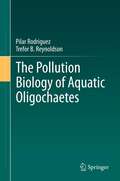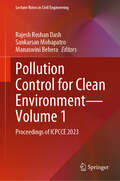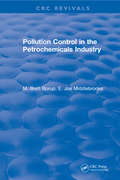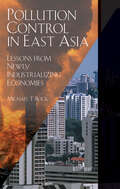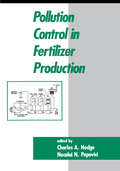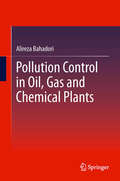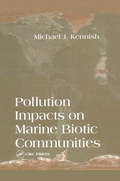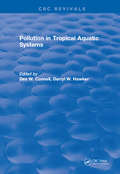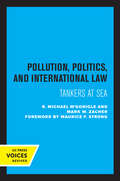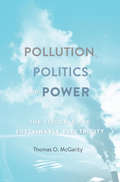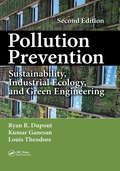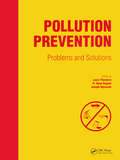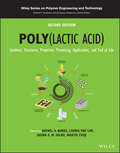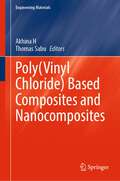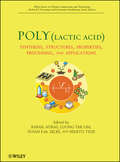- Table View
- List View
The Pollution Biology of Aquatic Oligochaetes
by Trefor B. Reynoldson Pilar RodriguezIn aquatic ecosystems, the oligochaetes are often a major component of the community. Their relevance in sediment quality assessment is largely related to their benthic and detritivorous life habit. In this book, we aim to present the state of the art of Pollution Biology using oligochaete worms in laboratory and field studies. Future research will require the combination of a variety of methodological approaches and the integration of the resulting information, avoiding fragmented and often conflicting visions of the relationships of the species with their environment. Current approaches to ecotoxicology and bioaccumulation using ecological risk assessment provide the opportunity to relate community studies with probability of effects. This book addresses three main themes: Ecological and Field Studies using the composition and structure of oligochaete communities, Toxicology and Laboratory Studies, and Bioaccumulation and Trophic Transfer Studies. Two appendices list values of toxicological parameters (LC50, EC50) and several bioaccumulation variables (bioaccumulation factors, biological half-life, toxicokinetic coefficients, and critical body residues) for different oligochaete species. Additional information is provided on Methodological Issues and on the Taxonomy of several oligochaete families, with information on the most recent taxonomic debates. Each chapter includes a critical view, based on the authors' experience, of a number of current issues which have been raised in the literature.
Pollution Control and Resource Reuse for Alkaline Hydrometallurgy of Amphoteric Metal Hazardous Wastes
by Zhang Chenglong Zhao YoucaiThis book provides a comprehensive description of alkaline hydrometallurgy of amphoteric metal hazardous wastes. Topics focus on leaching of zinc and lead hazardous wastes, purification of leach solution of zinc and lead, electrowinning of zinc and lead from purified alkaline solutions, chemical reactions taking place in the production flowsheets, thermodynamic and spent electrolyte regeneration, alkaline hydrometallurgy of low-grade smithsonite ores, recovery of molybdenum and tungsten using ion flotation and solvent extraction processes and their application in chemical synthesis of Nb and Ta inorganic compounds, and industrial scale production of 1500-2000 t/a zinc powder using alkaline leaching-electrowinning processes. Processes described are cost-effective, generate lesser secondary pollutants, and have been applied widely in China. Readers that will find the book appealing include solid waste engineers, environmental managers, technicians, recycling coordinators, government officials, undergraduates and graduate students, and researchers.
Pollution Control for Clean Environment — Volume 2: Proceedings of ICPCCE 2023 (Lecture Notes in Civil Engineering #416)
by Rajesh Roshan Dash Sankarsan Mohapatro Manaswini BeheraThis book presents select proceedings of the International Conference on Pollution Control for Clean Environment (ICPCCE-2023). It introduces readers to the recent emerging pollutants in air and water environments and in solid waste and sheds light on the newly developed control strategies. The book discusses various topics including the occurrence of emerging contaminants, micropollutants in water, wastewater and aquatic environments, occurrence pathways, surface and groundwater pollution, and risk and impact assessment of pollution. The chapters provide advanced information topics including effective monitoring, detection, sustainable practices, cleaner and innovative water and wastewater treatment technologies, and emerging contaminant removal. The book also includes information on energy-positive technologies and recent advances in the upgradation of existing systems. It also extensively discusses life cycle assessment and the application of environmental indicators and circular economy in pollution control strategies. The book covers the interaction of pollutants in the atmosphere and discusses innovative air pollution control strategies, including a detailed discussion of carbon capture and storage. The book presents various strategies for managing solid waste and discusses several novel technologies for the management of the present-day concern of plastic waste and e-waste. Given the present-day need for the recovery and re-use of various waste materials, this book delves extensively into how waste materials can be used for different purposes. It also talks about the recovery of energy and other useful by-products contributing towards economical and sustainable solutions. The book discusses various case studies on recently developed technologies and evaluates a wide range of technologies for pollutant removal and their implementation in the field. This book provides a ready reference for environmental engineers, practitioners, policymakers, and planners. It also served as a practical guide for industrial engineers, government bodies, ecologists, and researchers.
Pollution Control for Clean Environment—Volume 1: Proceedings of ICPCCE 2023 (Lecture Notes in Civil Engineering #415)
by Rajesh Roshan Dash Sankarsan Mohapatro Manaswini BeheraThis book presents select proceedings of the International Conference on Pollution Control for Clean Environment (ICPCCE-2023). It introduces readers to the recent emerging pollutants in air and water environments and in solid waste and sheds light on the newly developed control strategies. The book discusses various topics including the occurrence of emerging contaminants, micropollutants in water, wastewater and aquatic environments, occurrence pathways, surface and groundwater pollution and risk and impact assessment of pollution. The chapters provide advanced information topics including effective monitoring, detection, sustainable practices, cleaner and innovative water and wastewater treatment technologies, and emerging contaminant removal. The book also includes information on energy-positive technologies and recent advances in the upgradation of existing systems. It also extensively discusses life cycle assessment and the application of environmental indicators and circulareconomy in pollution control strategies. The book covers the interaction of pollutants in the atmosphere and discusses innovative air pollution control strategies, including a detailed discussion of carbon capture and storage. The book presents various strategies for managing solid waste and discusses several novel technologies for the management of the present-day concern of plastic waste and e-waste. Given the present-day need for the recovery and re-use of various waste materials, this book delves extensively into how waste materials can be used for different purposes. It also talks about the recovery of energy and other useful by-products contributing towards economical and sustainable solutions. The book discusses various case studies on recently developed technologies and evaluates a wide range of technologies for pollutant removal and their implementation in the field.This book provides a ready reference for environmental engineers, practitioners, policymakers and planners. It also served as a practical guide for industrial engineers, government bodies, ecologists and researchers.
Pollution Control for the Petrochemicals Industry
by M.Brett BorupThe petrochemicals industry is very complex and requires considerable knowledge of the individual processes to develop effective pollution control plans and processes. Information in this small book is intended to provide a base from which one can build. It is not exhaustive in describing the segments of the industry or pollution control techniques; however, it does provide a basic knowledge that should lead to intelligent, environmentally sound solutions to pollution prevention, control, and treatment.
Pollution Control Handbook for Oil and Gas Engineering
by Nicholas P. CheremisinoffThis is a major new handbook that covers hundreds of subjects that cross numerous industry sectors; however, the handbook is heavily slanted to oil and gas environmental management, control and pollution prevention and energy efficient practices. Multi-media pollution technologies are covered : air, water, solid waste, energy. Students, technicians, practicing engineers, environmental engineers, environmental managers, chemical engineers, petroleum engineers, and environmental attorneys are all professionals who will benefit from this major new reference source. The handbook is organized in three parts. Part A provides an extensive compilation of abbreviations and concise glossary of pollution control and engineering terminology. More than 400 terms are defined. The section is intended to provide a simple look-up guide to confusing terminology used in the regulatory field, as well as industry jargon. Cross referencing between related definitions and acronyms are provided to assist the user. Part B provides physical properties and chemical safety information. This part is not intended to be exhaustive; however it does provide supplemental information that is useful to a number of the subject entries covered in the main body of the handbook. Part C is the Macropedia of Subjects. The part is organized as alphabetical subject entries for a wide range of pollution controls, technologies, pollution prevention practices and tools, computational methods for preparing emission estimates and emission inventories and much more. More than 100 articles have been prepared by the author, providing a concise overview of each subject, supplemented by sample calculation methods and examples where appropriate, and references. Subjects included are organized and presented in a macropedia format to assist a user in gaining an overview of the subject, guidance on performing certain calculations or estimates as in cases pertinent to preliminary sizing and selection of pollution controls or in preparing emissions inventories for reporting purposes, and recommended references materials and web sites for more in-depth information, data or computational tools. Each subject entry provides a working overview of the technology, practice, piece of equipment, regulation, or other relevant issue as it pertains to pollution control and management. Cross referencing between related subjects is included to assist the reader to gain as much of a practical level of knowledge.
Pollution Control in East Asia: Lessons from Newly Industrializing Economies (Environmental Development Ser. #No. 9)
by Michael T. RockWhy do some economies seem to excel at effective pollution management while others miss the mark when responding to deteriorating urban environments? These studies of pollution management in East Asia's newly industrialized economies (NIEs) include successful government responses in Singapore and Taiwan, qualified results in China and Indonesia, and much more limited success in Thailand and Malaysia. In each example, Michael Rock considers the starting point of the economy as it began its path toward industrialization in the post World War II period. He discusses the relevant historical and political context, the pressures placed on the political system from domestic and international sources, and the influence of ongoing trends in East Asia for democratization and economic liberalization. Rock's text makes it clear that each economy found unique, innovative ways to link environmental protection to its own political and economic institutions. Thus, while public pressure from both home and abroad gave strong impetus to successful programs in Taiwan, the development of policy in Singapore involved limited public review and a centralized, government-led process. The result of Rock's scholarship is a book that provides important lessons without being reductionist. The book offers insights to apply to pollution management in a diverse range of developing nations, but avoids attempts for precise prescriptions, or universally appealing, normative answers. A copublication of Resources for the Future and the Institute of Southeast Asian Studies (ISEAS).
Pollution Control in Fertilizer Production (Environmental Science & Pollution)
by C.A. Hodge"This timesaving guide addresses nearly every aspect of pollution control for the mining, production, transportation, and distribution of chemical fertilizers covering current and emerging technologies for all segments of the industry, including raw materials production, end products, and by-products."
Pollution Control in Oil, Gas and Chemical Plants
by Alireza BahadoriThis book covers the fundamental requirements for air, soil and water pollution control in oil and gas refineries, chemical plants, oil terminals, petrochemical plants, and related facilities. In this concise volume, Dr. Bahadori elucidates design and operational considerations relevant to critical systems such as the waste water treatment units, solid waste disposal, and waste water sewer treatment as well as engineering/technological methods related to soil and air pollutions control. Engineers and technical managers in a range of industries will benefit from detail on a diverse list of topics.
Pollution Control in United States: Evaluating the System
by J. Clarence Davies Jan MazurekPollution control, a key component of U.S. environmental policy, has made important progress in recent decades. Yet important problems remain and there is need for improvement in the pollution control regulatory system. This book is the most extensive evaluation of that system ever produced. It reveals many strengths and accomplishments, but also illustrates serious shortcomings and the need for reform. The volume emerges from three years of research on a fragmented 'system' of institutions, statutes, and procedures that is often inefficient and ineffective, hobbled by misplaced priorities. Part I provides an in-depth description of this system, centered on the federal Environmental Protection Agency and the labyrinthine laws it must implement. The authors evaluate the federal legislation, administrative decisionmaking, and the state-federal division of labor that defines the system. Davies and Mazurek assess the effectiveness and efficiency of U.S. pollution control. They discuss the performance of U.S. laws and regulations in comparison with those of other nations, assess the ability of the U.S. pollution control system to meet future problems, and consider proposals for reform and repair. Within this far reaching analysis, they include criteria that are often overlooked by policymakers and analysts, including social values, equity, nonintrusiveness, and public participation.
Pollution Control Technologies: Current Status and Future Prospects (Energy, Environment, and Sustainability)
by Swatantra P. Singh Karthik Rathinam Tarun Gupta Avinash Kumar AgarwalThis monograph is based on pollution control technologies available to deal with water and air pollution. It includes removal of variety of pollutants including arsenic, chromium, uranium, pesticides and arsenic from water using adsorption technique. In addition, this book deals with the sampling and removal of microplastics using various techniques. The contents also focus on the role of membrane technology in water and wastewater treatment, and particulate matter air pollution and its control techniques. This volume will be a useful guide for researchers, academics and scientists.^
Pollution Impacts on Marine Biotic Communities (Crc Marine Science Ser. #14)
by Michael J. KennishPollution of estuaries and coastal marine waters is of profound ecological and societal importance. These coastal environments serve as critical habitat for a multitude of organisms and are of great commercial and recreational value to humans. Designed to meet the research, monitoring, and assessment needs of scientists, administrators, planners, and managers, Pollution Impacts on Marine Biotic Communities is a uniquely comprehensive reference covering pollution in coastal marine and estuarine waters. The book provides a detailed look at the short- and long-term impacts of pollutants on these ecologically important regions. Case studies that reflect a broad range of pollution problems are analyzed, outlining the real-life issues and providing solutions to common problems.Despite being highly sensitive systems, estuarine and coastal marine environments have served as repositories for dredge spoils, sewage sludge, and industrial and municipal effluents for many decades. The adverse effects of these pollutants are only now being fully realized and understood. Pollution Impacts on Marine Biotic Communities includes a basic introduction to the subject of pollution in estuarine and marine environments and also a detailed examination of specific marine pollutants. Both the coverage and the format - which includes abundant illustrations and tables - make this book a valuable reference for scientists, administrators, and students engaged in coastal research and planning.
Pollution in Tropical Aquatic Systems
by Des W. ConnellWe have identified a need to draw together knowledge of physiochemical and biological aspects of pollution in tropical aquatic systems. This book results from this and we hope will assist in providing management strategies to protect these systems from pollution effects. In organising the book we have, as far as possible, attempted to cover the range of topics important in understanding pollution in tropical areas. Authors who are expert in their particular fields have been invited to contribute. We recognise that many topics remain uncovered but we hope will serve to assist in identifying these and stimulate interest in this area.
Pollution, Politics, and International Law: Tankers at Sea
by R. Michael M’Gonigle Mark W. ZacherThis title is part of UC Press's Voices Revived program, which commemorates University of California Press’s mission to seek out and cultivate the brightest minds and give them voice, reach, and impact. Drawing on a backlist dating to 1893, Voices Revived makes high-quality, peer-reviewed scholarship accessible once again using print-on-demand technology. This title was originally published in 1979.
Pollution, Politics, and Power: The Struggle for Sustainable Electricity
by Thomas O. McGarityToday’s electric power companies compete to provide cleaner electricity. That’s a good thing, but progress has come with costs, especially for communities reliant on the coal industry. Thomas McGarity examines the changes of recent decades and offers ideas for building a more sustainable grid while easing the economic downsides of coal’s demise.
Pollution Prevention: The Waste Management Approach to the 21st Century
by R. Ryan Dupont Louis Theodore Kumar GanesanApplying pollution prevention strategies - the most viable environmental management option of the future - offers a cost-effective means of minimizing waste. Pollution Prevention: The Waste Management Approach to the 21st Century provides the background needed to understand not only pollution prevention but also waste control. Thorough, clear, and concise, it explains the fundamentals of pollution prevention and their applications to real-world problems. It explores pollution prevention through energy conservation, health and safety management, and accident prevention. The authors include illustrative examples and case studies that demonstrate the solutions offered.
Pollution Prevention: Sustainability, Industrial Ecology, and Green Engineering, Second Edition
by Ryan Dupont Kumar Ganesan Louis TheodoreThis new edition has been revised throughout, and adds several sections, including: lean manufacturing and design for the environment, low impact development and green infrastructure, green science and engineering, and sustainability. It presents strategies to reduce waste from the source of materials development through to recycling, and examines the basic concepts of the physical, chemical, and biological properties of different pollutants. It includes case studies from several industries, such as pharmaceuticals, pesticides, metals, electronics, petrochemicals, refineries, and more. It also addresses the economic considerations for each pollution prevention approach.
Pollution Prevention
by Louis TheodoreEngineering and science professionals have studied the management of hazardous and toxic wastes extensively, and it is clear that the principal option of the future will be waste minimization, or pollution prevention. At present, however, few practicing professionals have a working understanding of this approach, educators are just starting to teach course material in this field, and students are only beginning to receive the training necessary to implement pollution prevention in their future work environment. An applications-oriented workbook of more than 100 exercises, Pollution Prevention: Problems and Solutions covers a variety of topics closely relevant to this field. The workbook is the result of a National Science Foundation College Faculty Workshop designed to generate new ideas and innovative educative approaches in the emerging, interdisciplinary field of pollution prevention. Contents include a pollution prevention overview in addition to problems and solutions organized into the categories of basic concepts, pollution prevention principles, regulations, source reduction, recycling, treatment, chemical plant/domestic applications, case studies, and ethics. Readership: Academics and students of undergraduate or graduate courses on waste management, as well as decision makers and practising professionals in the pollution prevention industry.
Poly: Synthesis, Structures, Properties, Processing, Applications, and End of Life (Wiley Series on Polymer Engineering and Technology #6)
by Rafael A. Auras Loong-Tak Susan E. M. Selke Hideto TsujiThe second edition of a key reference, fully updated to reflect new research and applications Poly(lactic acid) – PLA, biodegradable polymers derived from lactic acid, have become vital components of a sustainable society. Eco-friendly PLA polymers are used in numerous industrial applications ranging from packaging applications to medical implants and to wastewater treatment. The global PLA market is predicted to expand significantly over the next decade due to increasing demand for compostable and recyclable materials produced from renewable resources. Poly(lactic acid) Synthesis, Structures, Properties, Processing, Applications, and End of Life provides comprehensive coverage of the basic chemistry, production, and industrial use of PLA. Contributions from an international panel of experts review specific processing methods, characterization techniques, and various applications in biomedicine, textiles, packaging, and environmental engineering. Now in its second edition, this fully up-to-date volume features new and revised chapters on 3D printing, the mechanical and chemical recycling of PLA, PLA stereocomplex crystals, PLA composites, the environmental footprint of PLA, and more. Highlights the biodegradability, recycling, and sustainability benefits of PLA Describes processing and conversion technologies for PLA, such as injection molding, extrusion, blending, and thermoforming Covers various aspects of lactic acid/lactide monomers, including physicochemical properties and production Examines different condensation reactions and modification strategies for enhanced polymerization of PLA Discusses the thermal, rheological, and mechanical properties of PLA Addresses degradation and environmental issues of PLA, including photodegradation, radiolysis, hydrolytic degradation, biodegradation and life cycle assessment Poly(lactic acid) Synthesis, Structures, Properties, Processing, Applications, and End of Life, Second Edition remains essential reading for polymer engineers, materials scientists, polymer chemists, chemical engineers, industry professionals using PLA, and scientists and advanced students engineers interested in biodegradable plastics.
Poly (Engineering Materials)
by Akhina H Thomas SabuThis book covers Poly(vinyl chloride) Fundamentals, Fabrication and characterization of PVC based composites and nanocomposites specifically natural fibre reinforced PVC composites, carbonaceous filler reinforced PVC composites , metal oxide fled PVC composites and nanocomposites etc. This book also covers the conducting PVC composites and recent advances in nanocomposites based on PVC .The rheological, mechanical, barrier, thermal, dielectric behaviour of PVC composites and nanocomposites are discussed in details.
Poly(lactic acid)
by Rafael A. Auras Loong-Tak Lim Hideto Tsuji Susan E. SelkeThis book describes the synthesis, properties, and processing methods of poly(lactic acid) (PLA), an important family of degradable plastics. As the need for environmentally-friendly packaging materials increases, consumers and companies are in search for new materials that are largely produced from renewable resources, and are recyclable. To that end, an overall theme of the book is the biodegradability, recycling, and sustainability benefits of PLA. The chapters, from a base of international expert contributors, describe specific processing methods, spectroscopy techniques for PLA analysis, and and applications in medical items, packaging, and environmental use.
Poly(o-aminophenol) Film Electrodes
by Ricardo TucceriThis review book is concerned with the synthesis, charge transport properties and practical applications of poly (o-aminophenol) (POAP) film electrodes. It is divided into three parts. The first one has a particular emphasis on problems of synthesis and structure of POAP. The second part deals with the mechanism of charge transfer and charge transport processes occurring in the course of the redox reactions of POAP. The third part describes the promising applications of POAP in the different fields of sensors, electrocatalysis, bioelectrochemistry, corrosion protection, among others. This review covers the literature on POAP in the time period comprised between 1987 and 2013.
Poly-SiGe for MEMS-above-CMOS Sensors
by Ann Witvrouw Kristin De Meyer Pilar Gonzalez RuizPolycrystalline SiGe has emerged as a promising MEMS (Microelectromechanical Systems) structural material since it provides the desired mechanical properties at lower temperatures compared to poly-Si, allowing the direct post-processing on top of CMOS. This CMOS-MEMS monolithic integration can lead to more compact MEMS with improved performance. The potential of poly-SiGe for MEMS above-aluminum-backend CMOS integration has already been demonstrated. However, aggressive interconnect scaling has led to the replacement of the traditional aluminum metallization by copper (Cu) metallization, due to its lower resistivity and improved reliability. Poly-SiGe for MEMS-above-CMOS sensors demonstrates the compatibility of poly-SiGe with post-processing above the advanced CMOS technology nodes through the successful fabrication of an integrated poly-SiGe piezoresistive pressure sensor, directly fabricated above 0.13 m Cu-backend CMOS. Furthermore, this book presents the first detailed investigation on the influence of deposition conditions, germanium content and doping concentration on the electrical and piezoresistive properties of boron-doped poly-SiGe. The development of a CMOS-compatible process flow, with special attention to the sealing method, is also described. Piezoresistive pressure sensors with different areas and piezoresistor designs were fabricated and tested. Together with the piezoresistive pressure sensors, also functional capacitive pressure sensors were successfully fabricated on the same wafer, proving the versatility of poly-SiGe for MEMS sensor applications. Finally, a detailed analysis of the MEMS processing impact on the underlying CMOS circuit is also presented.
Poly Trimethylene Terephthalate: Based Blends, IPNs, Composites and Nanocomposites (Materials Horizons: From Nature to Nanomaterials)
by A. R. Ajitha Sabu ThomasThis book explains general concepts of an important engineering thermoplastic polymer—polytrimethylene terephthalate (PTT). It describes preparation methods, characterization techniques, and various applications of PTT-based blends, IPNs, and composites. It also gives a clear idea about the engineering thermoplastic, PTT, and its importance in future. In addition to the basic concepts of PTT-based materials, the book also includes novel studies and issues on this topic. This book is an outcome of contributions by experts from different disciplines with various backgrounds and expertise. This book is useful for professionals, researchers, industrial practitioners, graduate students, and senior undergraduates of polymer science and engineering. Additionally, it is also beneficial for researchers working on materials science, surface science, bioengineering, chemical engineering, and nanomaterials. This book helps the researchers and students in expanding their knowledge in this field.
Polyamic Acids and Polyimides: Synthesis, Transformations, and Structure
by Michael I. Bessonov Vladimir A. ZubkovPolyamic Acids and Polyimides surveys significant developments in basic research in the chemistry and physics of polyamic acids and polyimides over the last several years. Traditional and new topics are discussed, including catalytical imidization, chemical reactions at thermal treatment, quantum-chemical study of synthesis and structure, properties of isolated molecules, and supermolecular and crystalline structures. The book will be an excellent reference for researchers, practitioners, and graduate students working with polyimides and related heat-resistant polymers and materials.
